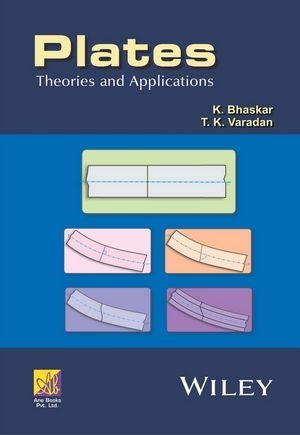Read more
Plates: Theories and Applications provides a comprehensive introduction to plate structures, covering classical theory and applications. It considers plate structures in several forms, starting from the simple uniform, thin, homogeneous metallic structure to more efficient and durable alternatives involving features such as variable-thickness, lamination, sandwich construction, fiber reinforcement, functional gradation, and moderately-thick to very-thick geometry. Different theoretical models are then discussed for analysis and design purposes starting from the classical thin plate theory to alternatives obtained by incorporation of appropriate complicating effects or by using fundamentally different assumptions. Plates: Theories and Applications alsocovers the latest developments on the topic.
List of contents
PART ACLASSICAL THEORY AND STRAIGHTFORWARD APPLICATIONS1 Definition of a Thin Plate 11.1 The Elasticity Approach 11.2 A Test Problem 41.3 The Case of a Thin Plate 72 Classical Plate Theory 112.1 Assumptions of Classical Plate Theory 122.2 Moment-Curvature Relations 162.3 Equilibrium Equations 182.4 Governing Biharmonic Equation 212.5 Boundary Conditions 212.6 Solution of a Problem 262.7 Inclusion of an Elastic Foundation / Thermal Effects 282.7.1 Elastic Foundation 282.7.2 Thermal Effects 292.8 Strain Energy of the Plate 303 A Critical Assessment of Classical Plate Theory 333.1 CPT Solution for the Test Problem of Section 1.2 333.2 Comparison with the Elasticity Solution 353.3 Why the Plane-Stress Constitutive Law? 374 Analysis of Rectangular Plates 404.1 Recapitulation of Fourier Series 404.2 Navier's Method 434.3 Levy's Method 504.4 Closed-form Solution for a Plate with Corner Supports 595 Analysis of Circular Plates 695.1 Equations of the Theory of Elasticity 695.2 Equations of CPT 715.3 Solution of Axisymmetric Problems 756 Free and Forced Vibrations 896.1 Equations of Motion 896.2 Free Vibration Analysis 916.3 Forced Vibration Analysis 997 Effect of In-plane Forces on Static Flexure, Dynamics and Stability 1037.1 Governing Equations for Combined Bending and Stretching 1037.2 Analysis for Stability 1087.3 Static Flexure 1157.4 Free Vibrations 1178 Approximate Solutions 1218.1 Analytical and Numerical Methods 1218.2 Rayleigh-Ritz Method 1228.2.1 Static Flexure 1228.2.2 Buckling 1308.2.3 Free Vibration Analysis 1408.3 Galerkin's Method 147Appendix - Solutions for Problems 162PART BCOMPLICATING EFFECTS AND CORRESPONDING THEORIES9 Anisotropic, Laminated and Functionally-Graded Plates 1919.1 CPT for Homogeneous Anisotropic Plates 1919.1.1 The Anisotropic Constitutive Law 1919.1.2 Plate Equations 1999.2 Classical Laminated Plate Theory 2039.3 CPT for Functionally-Graded Plates 21510 Elasticity Solutions for Plates 22010.1 Cylindrical Bending of a Cantilevered Plate Strip Under Tip Shear 22010.1.1 Homogeneous Strip 22110.1.2 A Laminated Strip 22810.2 Flexure of Simply Supported Rectangular Plates/Laminates Due to Transverse Loading 23310.3 Vibrations and Stability of Simply Supported Rectangular Plates and Laminates 23810.4 Solutions for Rectangular Plates with Other Edge Conditions 24010.5 Corner Reactions in Simply Supported Plates - Insight Obtained from Elasticity Solutions 24210.6 Plates under Thermal Loads 24611 Shear Deformation Theories 24811.1 First-order Shear Deformation Theory 24911.2 Higher-order Theories 26012 Variable Thickness Plates 26712.1 Stepped versus Smooth Thickness Variation 26712.2 Rectangular Plates 26812.3 Circular Plates 27213 Plate Buckling due to Non-Uniform Compression 27613.1 The In-plane Problem 27613.2 Determination of the Critical Load 28413.3 Some Other Approaches 28714 Non-Linear Flexure and Vibrations 29014.1 Cylindrical Bending of a Simply Supported Plate Strip 29014.1.1 Case (a): Immovable Edges 29014.1.2 Case (b): Freely Movable Edges 29914.1.3 Observations from the Above Solutions 30514.2 Moderately Large Deformation Theory 30614.3 Flexure of a Simply Supported Rectangular Plate 31214.4 Nonlinear Vibrations of a Rectangular Plate 31815 Post-Buckling Behaviour 32415.1 Post-Buckling of a Column 32415.2 Post-Buckling of a Rectangular Plate 32615.3 Effective Width 333Index
Summary
Plates: Theories and Applications provides a comprehensive introduction to plate structures, covering classical theory and applications. It considers plate structures in several forms, starting from the simple uniform, thin, homogeneous metallic structure to more efficient and durable alternatives involving features such as variable-thickness, lamination, sandwich construction, fiber reinforcement, functional gradation, and moderately-thick to very-thick geometry. Different theoretical models are then discussed for analysis and design purposes starting from the classical thin plate theory to alternatives obtained by incorporation of appropriate complicating effects or by using fundamentally different assumptions. Plates: Theories and Applications alsocovers the latest developments on the topic.

